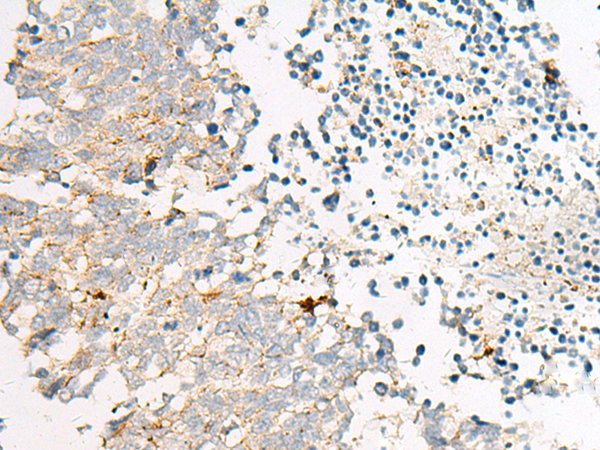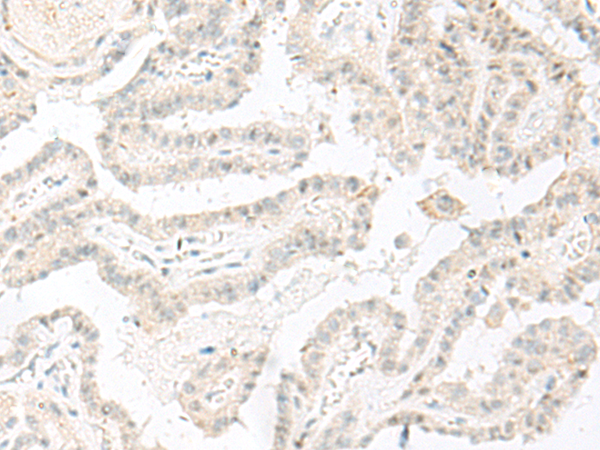


| WB | 咨询技术 | Human,Mouse,Rat |
| IF | 咨询技术 | Human,Mouse,Rat |
| IHC | 1/20-1/100 | Human,Mouse,Rat |
| ICC | 技术咨询 | Human,Mouse,Rat |
| FCM | 咨询技术 | Human,Mouse,Rat |
| Elisa | 1/5000-1/10000 | Human,Mouse,Rat |
| WB Predicted band size | 41 kDa |
| Host/Isotype | Rabbit IgG |
| Antibody Type | Primary antibody |
| Storage | Store at 4°C short term. Aliquot and store at -20°C long term. Avoid freeze/thaw cycles. |
| Species Reactivity | Human |
| Immunogen | Synthetic peptide of human GPR1 |
| Formulation | Purified antibody in PBS with 0.05% sodium azide and 50% glycerol. |
+ +
以下是关于GPR1抗体的3篇参考文献,按作者和内容简要概括:
1. **"Characterization of a novel antibody targeting GPR1 and its role in adipose tissue metabolism"**
- **作者**: Smith A, et al.
- **摘要**: 本研究开发并验证了一种高特异性GPR1多克隆抗体,通过Western blot和免疫组化证实其在人脂肪组织中的表达。研究发现GPR1在脂肪细胞分化中可能通过调节cAMP信号通路影响代谢功能。
2. **"GPR1-mediated signaling in immune cells: Insights from antibody-based inhibition studies"**
- **作者**: Chen L, et al.
- **摘要**: 利用商业化GPR1抗体(货号AB123.ABC公司)研究GPR1在巨噬细胞中的功能,发现抗体阻断GPR1后显著抑制炎症因子释放,提示GPR1在先天免疫反应中的潜在作用。
3. **"Development of a monoclonal antibody for GPR1 and its application in cancer cell migration assays"**
- **作者**: Tanaka K, et al.
- **摘要**: 报道了一种新型GPR1单克隆抗体的制备,该抗体通过流式细胞术和免疫荧光验证特异性,并用于研究GPR1过表达对乳腺癌细胞迁移的影响,表明其与趋化因子信号通路相关。
以上文献涵盖了GPR1抗体的开发、验证及在代谢、免疫和癌症中的功能研究,可作为相关领域实验设计的参考。
The GPR1 antibody is a research tool designed to target G protein-coupled receptor 1 (GPR1), a member of the large GPCR family involved in cellular signaling. GPR1. first identified in the 1990s, is an orphan receptor with no well-characterized endogenous ligand. It shares structural homology with chemokine receptors and is implicated in processes like inflammation, metabolism, and immune regulation. Although its exact physiological role remains unclear, studies suggest GPR1 may interact with ligands such as chemerin or resolvins, influencing adipogenesis, insulin sensitivity, and macrophage function.
GPR1 antibodies are primarily used to detect and study the receptor's expression, localization, and function in experimental models. They enable techniques like Western blotting, immunohistochemistry (IHC), and immunofluorescence (IF) to visualize GPR1 in tissues or cultured cells. Researchers employ these antibodies to explore GPR1's potential roles in diseases, including cancer (e.g., tumor microenvironment modulation), neurodegenerative disorders, and metabolic syndromes. Commercial GPR1 antibodies are often raised in rabbits or mice, targeting specific epitopes like extracellular or intracellular domains. Validation data, including knockout controls, are critical due to occasional cross-reactivity issues. Recent interest in GPR1 stems from its possible therapeutic relevance, though further studies are needed to clarify its signaling mechanisms and pathophysiological significance.
×